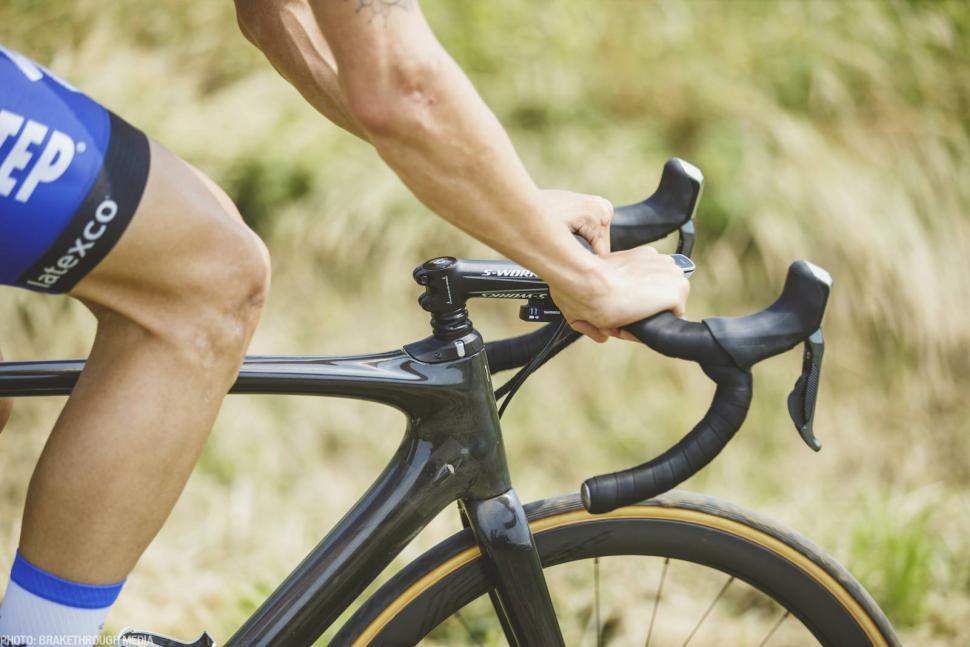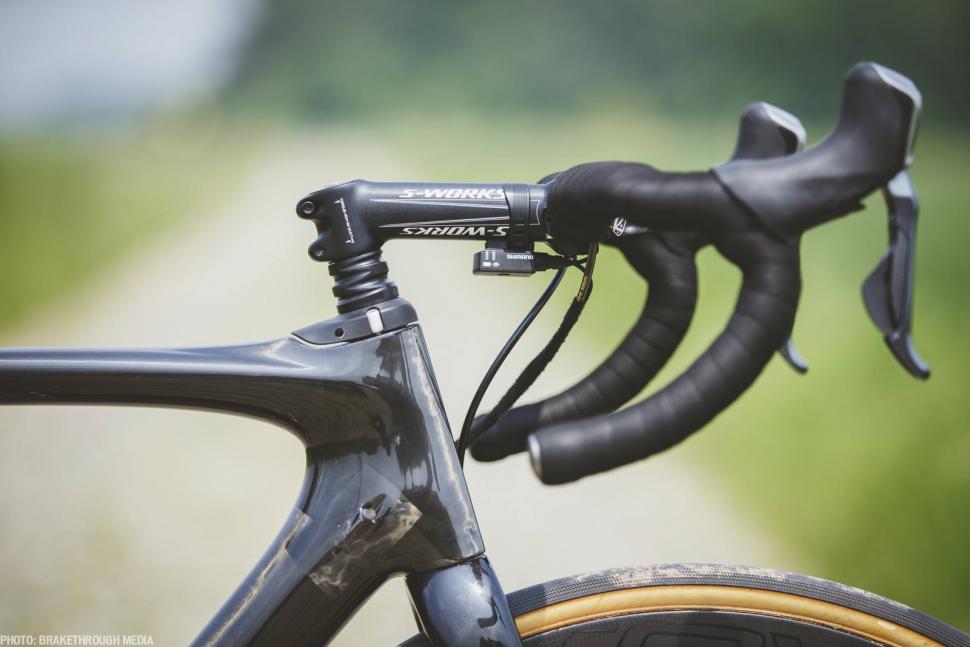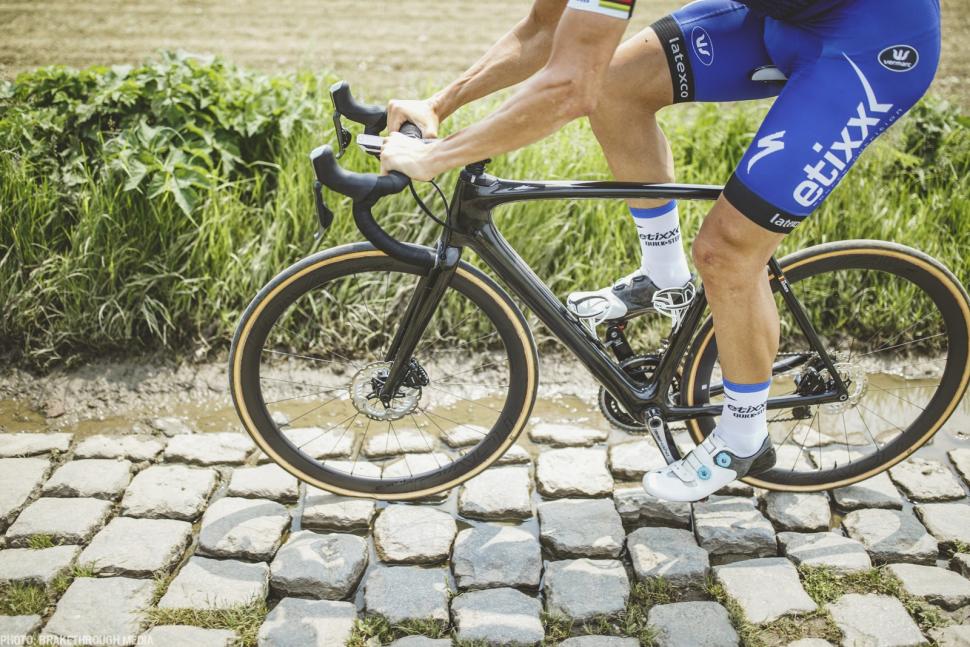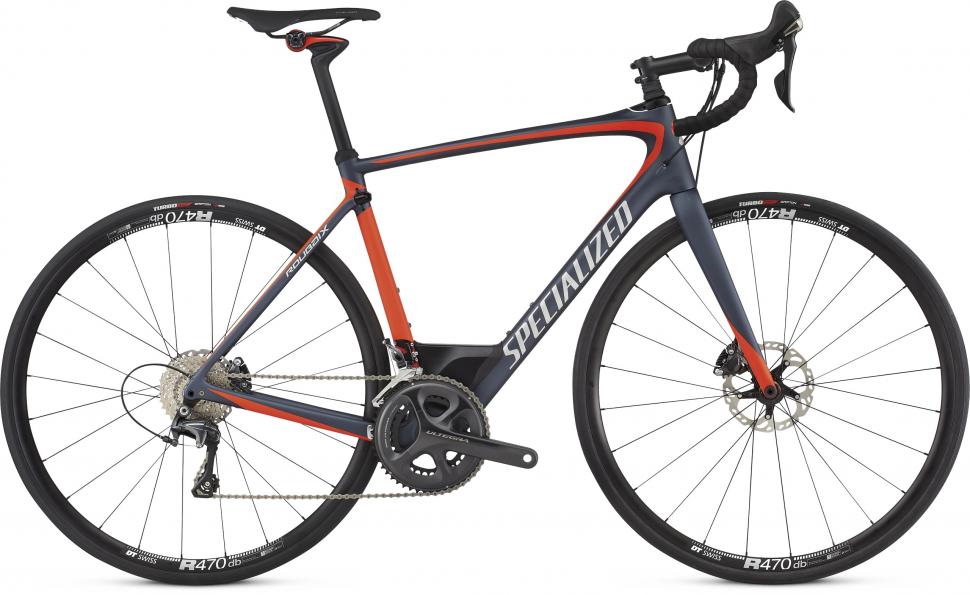- News
- Reviews
- Bikes
- Components
- Bar tape & grips
- Bottom brackets
- Brake & gear cables
- Brake & STI levers
- Brake pads & spares
- Brakes
- Cassettes & freewheels
- Chains
- Chainsets & chainrings
- Derailleurs - front
- Derailleurs - rear
- Forks
- Gear levers & shifters
- Groupsets
- Handlebars & extensions
- Headsets
- Hubs
- Inner tubes
- Pedals
- Quick releases & skewers
- Saddles
- Seatposts
- Stems
- Wheels
- Tyres
- Tubeless valves
- Accessories
- Accessories - misc
- Computer mounts
- Bags
- Bar ends
- Bike bags & cases
- Bottle cages
- Bottles
- Cameras
- Car racks
- Child seats
- Computers
- Glasses
- GPS units
- Helmets
- Lights - front
- Lights - rear
- Lights - sets
- Locks
- Mirrors
- Mudguards
- Racks
- Pumps & CO2 inflators
- Puncture kits
- Reflectives
- Smart watches
- Stands and racks
- Trailers
- Clothing
- Health, fitness and nutrition
- Tools and workshop
- Miscellaneous
- Buyers Guides
- Features
- Forum
- Recommends
- Podcast
TECH NEWS
Specialized launches all-new Roubaix with front suspension
Specialized has enjoyed huge success with its genre-defining Roubaix since its launch way back in 2003, and for 2017 there’s a brand new Roubaix which is the most radical version we’ve ever seen: it has a front suspension damper housed in the head tube.
- Buyer's guide: 2016 sportive and endurance road bikes
The launch of the original Roubaix ushered in Zertz dampers, sections of elastomers locate in key places like the fork blades and seatstays to provide added compliance. The endurance bike category has evolved rapidly over the years and most manufacturers have developed their own approach to providing a smoother rider, such as Bianchi with its CounterVail or Trek and its twin IsoSpeed decouplers.
It’s clear the market has moved on and Specialized felt the need to produce something radical for the long-awaited update of its popular Roubaix. In a nutshell, it has developed a frame that is lighter than the old Roubaix, has a damper unit housed in the top of the head unit to isolate the handlebars from the bumps and updated the fit and geometry with a lower stack than the previous model. Oh, and it takes 32mm tyres now and it’s disc brake only.
Through working with McLaren it developed a rolling efficiency simulator to help the company better understand what “smooth” actually means and how the rider and the road interact. Many endurance and comfort focused road bikes these days rely on splay deflection, where a part of the frame, fork or seat tube is able to move fore-and-aft. It only provides a limited amount of comfort, though. Specialized, through its testing, decided axial compliance, where the fork can move vertically up and down, provided the smoothest ride and met its criteria for the all-new Roubaix.
We're talking suspension, of course. To incorporate suspension into the front-end of the new Roubaix, it had two choices. Either between the head tube and fork (effectively a suspension fork) but with the downside of producing a taller front-end. Or it could put the suspension above the head tube and maintain the low front-end stack position. It went with the latter, with the most radical design we’ve yet seen on an endurance road bike, even including the latest Trek Domane and its flexing steerer tube.
The FutureShock
So the Zertz inserts have gone, and instead Specialized has developed the FutureShock, a cartridge damper that is located above the head tube and allows the stem and handlebars a range of 17mm of downward travel and 3mm of upward travel. The idea is to better isolate the rider from the bumps, cracks and cobbles in the road and provide improved traction. Specialized tells us the result is a 5.% improvement in vertical compliance over the previous Roubaix. As well as providing more comfort, it also promotes the benefits of increase traction, as the front wheel is able to better track the road surface.
The damper is a completely sealed unit, a tube within a tube with three small springs and rows of needle bearings keeping it smooth. It sits directly on top of the steerer tube with a special headset collar to house the bearings and the stem clamps onto the shock. The damper can be tuned with different springs to suit different weight riders. It's an elegantly simple design and not as complicated as it might sound - Specialized whipped it all apart in 30 seconds and showed us how easy it is to install and make changes to the setup.
We obviously asked about reliability and durability, and Specialized assures us it has carried out extensive testing to ensure it ticks those boxes. The system is completely sealed and wrapped with a rubber seal, so it looks as though it should cope with a British winter, and it recommends an 18-month service interval. We can definitely see applications for this technology beyond the Roubaix.
So that's the front-end taken care off. To provide some rear-end comfort, Specialized has completely reshaped the seat tube and rear triangle. The seatstays now meet the seat tube well below the top tube and the seat clamp is integrated into the seat tube, also well below the top tube. The seat tube also has a much bigger diameter than the seat tube it houses, so it can deflect more. There’s also the CG-R seatpost which carries over from the previous Roubaix with its built-in Zertz damper. It doesn't provide any figure for the improvement these changes offer over the previous Roubaix.
road.cc hasn’t ridden the new bike yet (a test bike is winging its way to us as you read this article) but we’ve felt the suspension by pushing down on the handlebars. Yes, it's not a test as such, but it revealed how remarkably sensitive to even the smallest input on the handlebars the damper is. According to the Specialized people we spoke to the ride feels very natural over rough roads and even when sprinting out of the saddle. Of course, they would say that, but we'll find out for ourselves when we get out on a test bike.
Some people accused the original Roubaix of having a head tube that was too tall. The new Roubaix has a geometry that is closer to its Tarmac race bike, but through a system of easily replaceable head tube top caps, the position of the original Roubaix can be achieved. So if you want it relatively slammed, you can but if you prefer the high position of the current Roubaix, that’s possible too.
To put some numbers on it, the new Roubaix has a 30mm lower stack and it’s also stretched the reach out 10mm. The fit and position can be adjusted both with a choice of head tube top covers or a choice of three handlebars with flat, mid and high shapes. It’s essentially trying to offer a huge range of adjustability and customisation.
The new Roubaix is also lighter than the old model. Even though the cartridge weighs 200g on its own, it’s managed to shed weight from the frame so that it now comes in at a claimed 700g with the fork adding 300g, so a bike close to the UCI weight limited should be easily possible.
One very interesting change is the switch to a traditional external threaded bottom bracket. Press-fit has lost a lot of fans over the years with customers and are manufacturers now listening? Could this be the start of the end for press-fit?
Specialized has also added SWAT (storage, water, air, tools) to the bike, a completely optional compartment that sits at the bottom of the down tube and is a smart alternative to a saddle bag or stuffed jersey pockets. It has rolled out SWAT already on its mountain bikes and it’s been quite successful there.
“The idea of a perfect road is a fantasy, and you don’t have to go all the way to the battered cobbles of Northern France to know this. We encounter this truth on every ride, after all. No matter how fresh or new the road, they’re all uneven, chipped, cracked, downtrodden—a homegrown version of our own Hell of the North. We believe, however, that one bike is capable of conquering along both fronts, for home and for eternal glory, and that bike is the all-new Roubaix.
There will be six Roubaix models priced from £1,900 for the Elite up to £7,500 for the eTap model. We’ve got one of the first test bikes coming to the office very soon and we’ll give you a first look at soon as it arrives.
Watch out for first look and first ride soon.
David worked on the road.cc tech team from 2012-2020. Previously he was editor of Bikemagic.com and before that staff writer at RCUK. He's a seasoned cyclist of all disciplines, from road to mountain biking, touring to cyclo-cross, he only wishes he had time to ride them all. He's mildly competitive, though he'll never admit it, and is a frequent road racer but is too lazy to do really well. He currently resides in the Cotswolds, and you can now find him over on his own YouTube channel David Arthur - Just Ride Bikes.
Latest Comments
- Davisian 11 min 28 sec ago
What's wrong with drivers parking their cars in car parks half a mile away and walking the rest of the way? Oh, I forgot, it's impossible for a...
- Bmblbzzz 21 min 46 sec ago
Engagement is definitely key. ...
- quiff 21 min 56 sec ago
I've responded to a few local consultations recently and have no doubt that when the changes are implemented, people will cry "but I wasn't...
- Pedal those squares 41 min 44 sec ago
IMHO he should be prosecuted to the full extent possible and band from all sporting events for a VERY long time. Otherwise there is no real...
- Spangly Shiny 57 min 47 sec ago
I'm pretty sure the dear lady is still very much alive and kicking. Reports of her demise are at least, a tad premature.
- Secret_squirrel 3 hours 2 min ago
Thats if you believe that a slightly bigger bearing surface translates in any meaningful way to "pedaling stiffness" which to my mind is the...
- chrisonabike 3 hours 8 min ago
Everyone carrying more / brighter searchlights will fix things? Perhaps it helps sometimes, but I think this leads to other issues. We're already...
- SecretSam 3 hours 9 min ago
Lake's naming and sizing: never knowingly comprehensible. Good shoes, baffling range.
- ChasP 3 hours 49 min ago
It could be used as a reliable comparison without any calculations.









































Add new comment
26 comments
So BikeRadar give it 5 stars and call it a game changer, after testing it on the cobbles and dirt roads but people on here slag it off without even riding it.
I've heard nothing but praise for this bike for those that have ridden it. I've seen loads of vids that show how well it works. I checked it out in the flesh and may test one soon. The only people slagging it off seem to be those that have never gone near the bike... :-\
Mat Hayman won Roubaix on a Scott Foil aero bike this year. Who needs suspension on a road bike?
Hideous.
Most could do better with a CC copy.
So by not suspending the entire frame they've:
1) Created a suspension system that doesn't bob up and down and kill the rider's (particularly out of seat) pedalling efficiency.
2) Made something that should handle more predictably because it doesn't introduce additional variation in the wheelbase geometry due to fork deflection or compression.
Yet still have a system that should work well from a suspension pov because the sprung (mostly rider) to unsprung ratio (bike) for most riders is likely to be large enough for it to work effectively.
All hypothetical of course, will see what people think when more get their hands on them.
EEK, that sounds worryingly like URT...
Specialized comes up with a something slightly gimmicky, and very slighly useful. Trek comes up with something gimmicky and useful. Cannondale comes up with something very gimmicky and very useful. Specialized counters with something gimmicky and slightly useful. Canyon comes up with something somewhat gimmicky and somewhat useful, and adds an integrated cockpit, because aero and light, because Canyon. Giant comes up with blanks, and adds a seatmast, because aero and light, because Giant.
Bike industry innovation in 2016.
Girvan Flex-stem anyone?
This is a suspension unit inline with the head tube - not a pivoting stem.
I'm aware of that, but its just another variation on a theme - i.e. put the 'shock absorber' at the stem/headtube interface
I don't know the exact details of how this new system on the Roubaix works but it appears that the whole stem/bar assembly slides up and down on a mechanism attached to the steerer tube. I wonder how they deal with the fore/aft loads on the steerer due to the fact that the force is being applied out at the bars, cantilevered out by the length of the stem? This would adversely affect the efficiency of the up/down damping/shock absorbtion. Doesn't seem a good engineering solution unless they have come up with a clever mechanism inside.
Just saw the new Rose X-lite disc takes 32 mm tires and you can have a etap for a little over 4K
https://www.rosebikes.co.uk/bike/rose-x-lite-cdx-8810/aid:890198
Are Specialized persisting with their own spec SCS hubs?
This. It was enough to put me off one of the better Diverge models.
edit: trip to Spesh website and it's 142mm through axle on the rear. Goodbye SCS!
Want proper suspension, great big tyres and a vast range of gear ratios on a comfortable road bike?
Why not buy a hardtail mountain bike and put some slick tyres on it?
Good luck with getting a comparable top speed and real wide gear range for MTBs; the best I could do recently was to fit a 9 speed Deore Hollowtech gear set (*) with 48T "trekking" triple to my old MTB and that was only because it originally had a square taper 50T 7 speed Altus triple, so already had enough frame clearance for a road size chainset.
10+ speed MTB gearsets are useless for speed because they don't even offer 48T "trekking" triple chainsets now and are expensive(!), most have IMO inferior single chainsets (less real gear range and more chain bend bearing wear) and some current MTB frames may not have enough frame clearance near the bottom bracket for even a 48T triple MTB chainset!
(*) Non-hollow bottom bracket gearset parts suck for creaks, and/or significantly reducing availability and increasing cost, so I'll reject any bicycle sold with these inferior chainsets. I'm also surprised that Shadow type rear derailers are not the standard design now because of no cable cover flex for shifting and much less risk of hanger damage from side impact on the gear side, including from a bike falling over or side impact from a crash.
Gone are the days when you could put a 50T chainring on a your hardtail
I was looking at comp disc and saving up my £2000, when it went on sale at £1500 almost ran to shop... But told to hang on the new one a game changer.... Very disappointed that the new improved at £2400. 20% more for not a lot Time to look at other brands. I feel this isn't good value. .. But nice colours.
"Game changing"???
So nothing at all like the Cannondale HeadShok Silk road bikes that were around in1999/2000? And those had the added bonus of being able to be locked-out on the fly.
You youngsters......!
I would imagine that even now Specialized's legal team is thinking of a way they can sue Cannondale for patent infringement...
Good to see they're also thinking about those who want to disguise a motor.
It's a nice looking bike and the tech is very interesting but as with a lot Specialized's bikes; it's the pricing that get's me.
£1,900 for the Elite up to £7,500. That's nearly 2 grand for a bike equipped with Tiagra and 7 grand for the top model. Forgetting the likes of Canyon etc but that's into custom geometry territory, if comfort is your primary goal, you could get a steel (or carbon) framed 'artisan' bike built specifically for you. I’m sure it would be just as fast too. Comfort is also subjective, if your an amateur who wants comfort, you’d do just as well to buy a CX bike (or a derivative) and get the comfort associated with fatter tyres…
Obviously this is all subjective but I often feel with the 'big brands' you're paying top-draw prices for their own R&D...
Cool they're experimenting, but after the novelty wears off you're left with a rather pricey, goofy looking front end with dubious benefits over a small drop in psi on a regular bike.
It's also more complex, ie. more proprietary stuff to fix and replace, but you can levy that at pretty much anything new these days.
Main concern is the goofyness. Guarantee you can find an equally great and comfortable ride that looks class.
Sure it's a great bike though, BR raving about it. Though never truly mentioned that it was fast, which is telling as BR love repeating how fast every bike is.
The lengths they will go too in order to avoid putting bigger tyres on bikes are just incredible!
It looks to me like they are easing the market back towards a big supple tyre (like a 1950s, 60 or 70s road bike would have had), but they can't do it in one big jump or the reviewers and buyers will just put misconseptions onto it and it will fall on its face. On they way they have to put complex suspension systems on bikes which the marketeers love.
The most advanced thing on this race bike are those big supple 32mm race tyre, its gonna feel great because of that, thats the bit I want on my bike! A little while down the line the cobbles bikes are going to have 40mm tyres. (unless there is some sort of UCI rule against it that everybone that buys an endurance bike and never races will have to stick to as well).
I'm sure the rest of the engineering on this bike works to a certain degree and it is probably there because its something to sell..that and the average joe is going to pump the tyres up to 100psi in the falsly held belief that it will make the bike go faster.
Here are my estimates:
Interesting approach. This has most of the same benefits and weaknesses as suspension stems.
I think that putting the suspension between the bars and the frame is an inferior solution to putting it between the wheel and the frame for a few reasons:
- The moving parts are between the bars and the bottom bracket. This is likely to make riding out of the saddle less significantly less efficient and possibly downright unnerving.
- The unsprung mass is significantly higher, making the suspension less effective at maintaining grip.
- The sprung mass is slightly lower, making the suspension slightly less effective at absorbing bumps.
The justification for this design choice makes no sense. You can design the frame so that the stem is in exactly the same position whether the suspension is above or below the head tube. It's more likely that the driving force was actually trying to make it look more like a normal road bike. This is probably because so many road cyclists seem not to accept that form should follow function! (eg "disc brakes are ugly!")
Personally I think a well engineered road-specific suspension fork (and a frame designed around it) is the best solution for Paris-Roubaix. It just isn't fashionable. And the UCI would probably ban it!
I suspect it would take more than 30s to swap out the springs if they put it beneath the head tube.